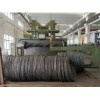
The inverse relationship between the U.S. dollar and commodity prices continues to cause problems for raw material producers. The prices of many commodities peaked in 2011. Since then, a secular bear market has taken prices lower.
In May 2014, the dollar bottomed at 78.93 on the active month dollar index futures contract that trades on the Intercontinental Exchange. By March 2015, the dollar rallied to highs of 100.38, an increase of over 27% in ten months.
Between March and early November, the dollar index underwent a period of correction and consolidation. However, the dollar broke out to the upside on November 6 and has made a series of higher lows and higher highs since. The prospects for a rise in U.S. interest rates and a general environment of higher dollar rates has been supportive for the U.S.
currency. There has been moderate growth in the U.S. economy while the rest of the world continues to attempt to stimulate their economies with quantitative easing and low interest rates.
While commodity prices began falling in 2011 and 2012, the stronger dollar has caused the decline in raw material prices to pick up steam starting in May 2011. As the dollar broke higher in November 2015, many commodity prices retreated to support levels. In some cases, they made new multiyear lows. On December 3, the price of gold fell to lows of $1045.40 per ounce, the lowest level since February 2010. On November 23, copper moved to $2.0020 per pound, the lowest since May 2009. Crude oil fell below the August 24, 2015 lows at $37.75 and traded down to $35.16 on December 11.
Key support in NYMEX crude oil is at the December 2008 lows at $32.48 per barrel. While the dollar corrected lower after making highs on December 3 at 100.70 on the March dollar index futures contract, the strength of the currency continues to weigh on the price of many commodities.
As you can see, the strong dollar has had an effect on these major raw material values.
In many ways, it has been a perfect bearish storm for raw material values. Slower growth in China, the world's largest commodity consumer has contributed to price weakness. There are so many more examples of commodities that have fallen dramatically in the face of a rising U.S. currency. Other metals, energy, soft commodities and agricultural prices have also moved lower. Weather and specific supply issues accounted for the commodity markets that have seen gains during 2015. The prospects for a continuation of a rally in the dollar are high given the prospects for a short-term interest rate hike in the U.S.
The chief competing currency for the dollar is the euro. Weak economic conditions in Europe have weakened the euro. Another bailout of Greece during the summer of 2015 put pressure on the European currency. High rates of unemployment in Southern Europe have contributed to weakness for the currency. Additionally, a humanitarian refugee crisis presents economic pressures on the continent. In November, a terrorist attack in Paris, France, is yet another issue for the euro. In many senses, Europe depends at least partially on tourism for revenue and increased fears of other terrorist events are likely to cause the number of tourists visiting to decline.
In other areas of the world, the decline in raw material prices itself weighs on currency values. Brazil, Australia, Russia, Canada and other nations depend on commodity sales for revenue. As these raw material values decline, so do their revenue flows. This creates a depressive effect on their currencies versus the dollar and a vicious cycle of selling in commodities. The lower commodity prices go the lower these currencies fall and that means that the dollar becomes stronger putting additional pressure on these currencies and commodity prices at the same time.
The technical trend in the dollar was higher until a correction began on December 3, 2015. Over the medium-term, momentum and trajectory point to a stronger dollar. Fundamentals also point to a higher dollar given U.S. growth relative to the rest of the world and the fact that the United States, with the exception of agricultural commodities and energy, is a commodity-consuming nation. Lower raw material prices provides additional stimulus to the U.S. economy in many senses. The great dollar bull market that began in May 2014 continues to put pressure on commodity prices and it is likely that this will continue in 2016.






